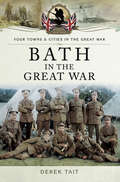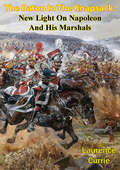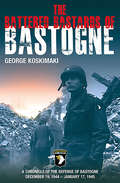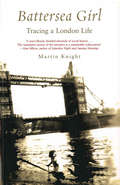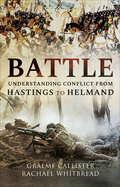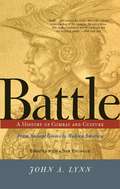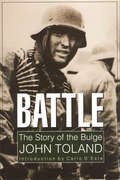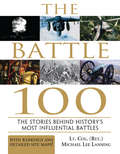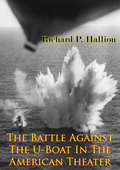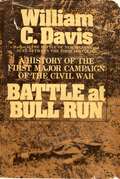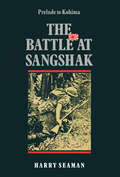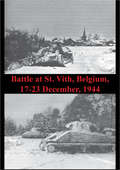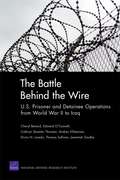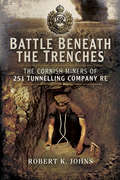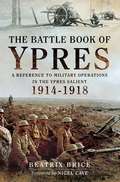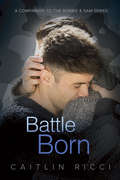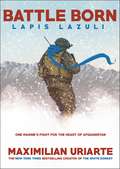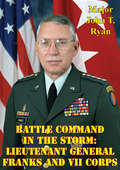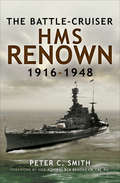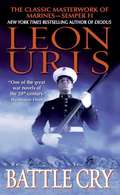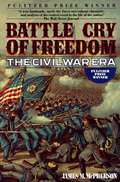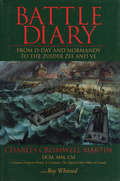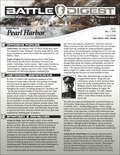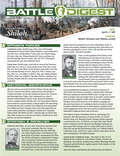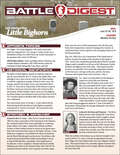- Table View
- List View
Bath in the Great War (Your Towns & Cities in the Great War)
by Derek TaitWhen news of the war broke out in 1914, nothing could prepare the citizens of Bath for the changes that would envelop their city over the next four years. The story of Bath in the Great War is both an interesting and intriguing one. This book covers this historic city's involvement from the commencement of the Great War in July 1914, to the Armistice in November 1918, describing in great detail what happened to the city and its people, including their everyday lives, entertainment, spies and the internment of aliens living within the city. Bath played a key role in the deployment of troops to Northern Europe as well as supplying vital munitions. Local men responded keenly to recruitment drives and thousands of soldiers were billeted in the city before being sent off to fight the enemy overseas. The city also played a vital role caring for the many wounded soldiers who returned home from the front. As the end of the war was announced there were tremendous celebrations in the streets, but the effects of war lasted for years to come. By the end of the conflict, there wasn't a family in Bath who hadn't lost a son, father, nephew, uncle or brother. Bath features many forgotten news stories of the day and includes a considerable collection of rare photographs last seen in newspapers nearly 70 years ago.
The Baton In The Knapsack: New Light On Napoleon And His Marshals
by Laurence CurrieTHE purpose of this book is to sketch briefly the career of Napoleon, especially his relations with his marshals, and to consider how far the marshals were responsible for the rise of the Napoleonic Empire and how some of them at any rate contributed to its fall.It was a saying among the rank and file of the armies of revolutionary France that every soldier carried in his knapsack the bâton of a marshal. This was to prove truer than is usual with such dicta; for more than half of Napoleon's marshals did actually arise from the ranks.In reviewing the period, the student of history can hardly fail to be fascinated by the deeds of valour casting a halo of romance over the entire epoch and to feel that wars productive of so many heroes can hardly have been fought in vain.Mechanical inventions have since degraded the art of war, robbed it of all glamour and added greatly to its horrors. Cavalry charges, such as those which proved decisive at Marengo and at Friedland, are now impossible; but, so long as mankind takes any interest in the past, the story of these mighty contests will always stir the imagination and perhaps excite the envy of future generations.
The Battered Bastards of Bastogne: A Chronicle of the Defense of Bastogne December 19, 1944–January 17, 1945
by George Koskimaki&“Fleshes out in vivid detail the entire story of the Screaming Eagles&’ valiant struggle . . . This is must reading for any student of World War II history&” (Kepler&’s Military History).The Battered Bastards of Bastogne is the product of contributions by 530 soldiers who were on the ground or in the air over Bastogne. They lived and made this history, and much of it is told in their own words. The material contributed by these men of the 101st Airborne Division, the Armor, Tank Destroyer, Army Air Force , and others is tailored meticulously by the author and placed on the historical framework known to most students of the Battle of the Bulge. Pieces of a nearly 60-year-old jigsaw puzzle come together in this book, when memoirs from one soldier fit with those of another unit or group pursuing the battle from another nearby piece of terrain.
Battersea Girl: Tracing a London Life
by Martin KnightA couple of years ago, Martin Knight began a quest to delve into his family history. He had a head start on many amateur genealogists, as 30 years earlier he had produced a school project on the very subject. The project was based on the papers and oral history of his then elderly grandmother, Ellen Tregent. Martin dusted this off and began to assemble the chain of events that shaped his grandmother's life. He even made contact with several living relatives who had known Ellen or some of the people and events she described.Ellen Tregent was born in 1888 and died in 1988 - her lifetime encompassing an unprecedented century of social change and world upheaval. She was born into a poor working-class family in Battersea, London. Her grandfather had arrived from Ireland 40 years earlier to escape almost certain death as potato famine ravaged his country. In Battersea Girl, Martin Knight charts Ellen's long and eventful life and the lives of her siblings. They encounter abject poverty, disease, suicide, murder, war and inevitably death, but, equally, the spirit of stoical people who were determined to make the most of their lives shines through in this enchanting book.
Battle: Understanding Conflict from Hastings to Helmand
by Graeme Callister Rachael WhitbreadWhat are the critical factors that determine the outcome of battles? Which is more decisive in a clash of arms: armies or the societies they represent? How important is the leadership of the commanders, the terrain over which the armies fight, the weapons they use and the supplies they depend on? And what about the rules of war and the strategic thinking and tactics of the time? These are among the questions Graeme Callister and Rachael Whitbread seek to answer as they demonstrate the breadth of factors that need to be taken into account to truly understand battle. Their book traces the evolution of warfare over time, exploring the changing influence of the social, political, technological and physical landscape on the field of battle itself. They examine how the motivation of the combatants and their methods of fighting have changed, and they illustrate their conclusions with vivid, carefully chosen examples from across a range of Western European military history, including the Norman Conquest, the Hundred Years War, the Wars of Religion, the Napoleonic Wars and the world wars, and beyond. By exploring the wide range of interconnected factors that influence the results of battles, the authors broaden the study of this aspect of military history from a narrow focus on isolated episodes of conflict. Their original and thought-provoking writing will be fascinating reading for all students of warfare.
Battle: A History of Combat and Culture
by John A LynnBattle: A History of Combat and Culture spans the globe and the centuries to explore the way ideas shape the conduct of warfare. Drawing its examples from Europe, the Middle East, South Asia, East Asia, and America, John A. Lynn challenges the belief that technology has been the dominant influence on combat from ancient times to the present day. In battle, ideas can be more far more important than bullets or bombs. Carl von Clausewitz proclaimed that war is politics, but even more basically, war is culture. The hard reality of armed conflict is formed by - and, in turn, forms - a culture's values, assumptions, and expectations about fighting. The author examines the relationship between the real and the ideal, arguing that feedback between the two follows certain discernable paths. Battle rejects the currently fashionable notion of a "Western way of warfare" and replaces it with more nuanced concepts of varied and evolving cultural patterns of combat. After considering history, Lynn finally asks how the knowledge gained might illuminate our understanding of the war on terrorism.
Battle: The Story of the Bulge
by John Toland Carlo D'Este"The perspective of 15 years, painstaking research, thousands of interviews, extensive analysis and evaluation, and the creative talent of John Toland [paint] the epic struggle on an immense canvas. . . . Toland writes with the authority of a man who was there. . . . He tastes the bitterness of defeat of those who surrendered and writes as if he had the benefit of the eyes and ears of soldiers and generals on the other side of the line. . . . If you could read only one book to understand generals and GIs and what their different wars were like this is the book."—Chicago Sunday Tribune "The author has devoted years to studying memoirs, interviewing veterans and consulting military documents, both German and American. He also has revisited the old battlefields in Belgium and Luxembourg. . . . Toland has told the whole story with dramatic realism. . . . It is a story of panic, terror and of high-hearted courage."—New York Times Book Review "For the first time in the growing literature of World War II, the inspiring story of the stubborn, lonely, dogged battle of the Americans locked in this tragic salient is told. . . . gripping . . . You cannot put it down once you start it."—San Francisco Chronicle
The Battle 100
by Michael Lee LanningA single day in the heat of armed conflict can shape the future of the world. Throughout history, individual battles have inspired the birth of nations, the devastation of cultures and the triumph of revolutions. Yet while some battles rise up as the cornerstones of history, others fade in our cultural memory, forgotten as minor skirmishes. Why is this so? What makes a battle "important"?Celebrated veteran and military expert Michael Lee Lanning offers a provocative response with The Battle 100: The Stories Behind History's Most Influential Battles. Lanning ranks history's 100 greatest battles according to their influence, both immediate and long-term. Thought-provoking and controversial, Lanning's rankings take us to the heart of the battles and reveal their true greatness.
The Battle Against The U-Boat In The American Theater [Illustrated Edition] (The U.S. Army Air Forces in World War II #6)
by Richard P. HallionIncludes 20 IllustrationsIn 1942 the Allied powers faced the most serious challenge to their control of the seas encountered in the Second World War: the menace of the U-boat. Fast, well- armed, and long-ranged, Hitler's submarines attacked shipping throughout the North Atlantic, often within sight of America's coastal towns and cities.Eventually, the combination of intelligence, land and sea- based air power, and surface vessel operations from both North American and British bases ended this threat, making possible the Allied build-up for the invasion of Europe in 1944.Flying radar-equipped long-range patrol planes, AAF airmen demonstrated the value of land-based air power against naval threats. This success has been reaffirmed consistently since the Second World War, from Vietnam and crises such as the Mayaguez incident to operations in Desert Shield and Desert Storm. The Harpoon-armed B-52s of our present-day global Air Force are the heirs of a sea-control tradition dating to the AAF's A-29s and B-24s of the Second World War.
Battle at Bull Run: A History of the First Major Campaign of the Civil War
by William C. DavisTwo great, untested armies were readying for the first--and what many believed would be the last--major conflict between North and South. On the eve of July 21, 1861, one Northerner wrote: "The sky is perfectly clear, the moon is full and bright, and the air was still as if it were not within a few hours to be disturbed by the roar of cannon and the shouts of contending men." So optimistic were the people in Washington that a crowd of civilians came from the city with picnic hampers to witness the crushing defeat of the upstart "rebels." It was, says William C. Davis, "the twilight of America's innocence," and the following day the mood would shatter in a battle that confounded the expectations of both sides--the first Battle at Bull Run. William C. Davis has written a compelling and complete account of this landmark conflict. The Battle at Bull Run (or Manassas) is notable for many reasons. It was a surprise victory for the Confederacy, a humiliating defeat for the Union, and the first ominous indication that a long and bloody war was inevitable. It marked the first strategic use of railroads in history, and the first time the horrors of the battle were photographed for the folks back home. It was also a training ground for some of America's most colorful military figures: P.G.T. Beauregard, Joe Johnston, Irvin McDowell and "Stonewall" Jackson. Drawing from a wealth of material--old letters, journals, memoirs and military records--Davis brings to life a vivid and vital chapter in American history.
The Battle At Sangshak: Prelude to Kohima
by Harry SeamanThis book tells the story of a small, yet significant, battle that was a precursor to the better known battles for Imphal and Kohima.
Battle At St. Vith, Belgium, 17-23 December, 1944 [Illustrated Edition]
by AnonIncludes 11 excellently detailed mapsThis is the narrative of one phase of the greatest pitched battles on the Western Front in World War II. The battle of St. Vith is an excellent example of how American Troops held their ground in the midst of confusion, defeat, and uncertainty; and thereby threw the German timetable sufficiently off schedule to allow American forces to regroup, hold, and then counterattack. The stand at St. Vith has been recognized by both German and Allied commanders as a turning point in the Battle of the Bulge.
The Battle Behind the Wire: U. S. Prisoner and Detainee Operations from World War II to Iraq
by Cathryn Quantic Thurston Andres Villamizar Elvira N. Loredo Cheryl Benard Edward O'ConnellThis report finds parallels in U.S. prisoner and detainee operations in World War II, Korea, Vietnam, and Iraq: underestimation of the number to be held, hasty scrambling for resources, and inadequate doctrine and policy. Later, attempts to educate and influence prisoners and detainees are often made. The authors recommend that detailed doctrine should be in place prior to detention and that detainees should be interviewed when first detained.
Battle Beneath the Trenches: The Cornish Miners of 251 Tunnelling Company RE
by Robert JohnsUndermining the positions of the enemy is one of the most ancient activities. For almost 3000 years even before 1914, it was a popular siege-breaking technique. During the Great War, arguably the greatest siege the world had ever seen, it presented a conflict environment that perfectly favoured the skills of the military miner. During 1915, the Western Front was established as a static line that grew into a huge network of defence-in-depth earthworks. Siege conditions demanded siege tactics and as the ground was everywhere mineable, the Western Front was a prime candidate for underground warfare.Royal Engineer tunnelling companies were specialist units of the Corps of Royal Engineers within the British Army, formed to dig attacking tunnels under enemy lines during the First World War. The Cornish Miners were one of these specialist units recruited from the tin mines of Cornwall.In February 1915, eight Tunnelling Companies were created and operational in Flanders from March 1915. By mid-1916, the British Army had around 25,000 trained tunnellers, mostly volunteers taken from mining communities. This is their story.
The Battle Book of Ypres: A Reference to Military Operations in the Ypres Salient 1914–1918
by Beatrix BriceOf the many hard-fought battles on the Western Front, Ypres stands out as an example of almost inhuman endeavour. For four long years it was the focal point of desperate fighting. Officially there were four main battles in 1914, 1915, 1917 and 1918; these were more accurately peaks in a continuing struggle, for Ypres symbolised Belgian defiance, and the British continued to expend disproportionate resources on defending it. It never fell, although the Germans came close to its gates, and indeed its loss would have been a severe blow to morale.The Battle Book of Ypres, originally published in 1927 and now presented again as a special Centenary Edition, comprises a chronological account of the fighting in the Ypres Salient during the First World War, followed by a useful and unique alphabetical reference to the events in and around each hamlet, village or wood names familiar to those who fought or followed the course of war all those years ago, names now once again lost in insignificance. The names given to each stage of the struggle by the Battle Nomenclature Committee are listed in the appendix. Also included is an index of formations and units, an annotated bibliography and a new Foreword by military historian Nigel Cave.
Battle Born (Robbie & Sam)
by Caitlin RicciA Companion to the Robbie & Sam SeriesDaniel Messana wanted a way out of Thornwood, Colorado, and he found it in the Army. Now he’s returned with no more direction to his life than he had when he left as an angry teenager. And even though the war is behind him, the things he experienced won’t leave him in peace. His PTSD plagues him in crowds, and isolation sets in when he’s by himself. Because of the way he treated his brothers, regret gnaws at him, and he has no family to turn to. For Franklin “Coop” Cooper, the Army was life, and one he loved. But when an IED in Afghanistan left him blind, it ended not only the career he’d built, but any chance of being his own man. Back home, his parents refuse to let him do anything for himself, even though Coop and his service dog are ready to move forward and adjust to his new conditions. His only escape from being coddled like a child is going for pizza on base while his mother shops on Fridays. There, Daniel sits down next to him, and the two men begin a friendship that could become more—if they can break free from everything holding them back.
Battle Born: Lapis Lazuli
by Maximilian UriarteFrom the bestselling author of The White Donkey, a heartbreaking and visceral graphic novel set against the stark beauty of Afghanistan's mountain villages that examines prejudice and the military remnants of colonialism.In this hotly anticipatednew work from Maximilian Uriarte, creator of the popular Terminal Lance comics and The White Donkey, tells a "thrillingly cinematic" (Publishers Weekly) story of the personal cost of war and the power of human connection. Lapis Lazuli is a rich blue semiprecious gemstone found deep in the Sar-i-sang mountains of Afghanistan's Badakhshan province. For thousands of years it has sustained the nearby mining villages, whose inhabitants lived peacefully in the mountainous landscape--until the Taliban, known in the region as the Horsemen, came to seek the riches stored deep beneath the earth. Taliban rule has turned the stone into a conflict mineral, as they steal and sell it for their own gain. At the behest of the fledgling Afghan government, seeking to wrest back control of the province, United States Marines are sent into the mountains. A platoon led by their eager and naive commander, First Lieutenant Roberts, and a stoic, fierce squad leader, Sergeant King, must overcome barriers of language and culture in this remote region to win the locals' trust, and their freedom from Taliban rule. Along the way, they must also wrestle with their demons--and face unimaginably difficult choices.A sweeping yet intimate story about brutality, kindness, and the remnants of colonialism, Battle Born: Lapis Lazuli is an epic saga from the voice of a new generation of military veterans.
Battle Command In The Storm: Lieutenant General Franks And VII Corps
by Major John T. RyanThis study examines the concept of battle command from a modem historical perspective. It analyzes the decision making and leadership displayed by Lieutenant General Franks during the planning, preparation and execution of Operation Desert Storm to determine if General Franks exhibited the principles of battle command. Decision making and leadership are the two major components of battle command, a concept championed by Franks following Desert Storm, and, as such serve to frame the discussion. As the commander of the U.S. VII Corps during Operation Desert Storm, General Franks made decisions that had tactical, operational, and strategic implications. These decisions directly affected the lives and actions of the over 142,000 U.S. and British service-members assigned to his command. The results were overwhelmingly successful but many criticized him for being too cautious and conservative. This study investigates if the criticism founded in fact or whether General Franks was merely striking the best balance possible between decision making and leadership on the battlefield.
The Battle-Cruiser HMS Renown, 1916–48
by Peter C. Smith&“A successful book, giving a picture of life on a major warship, as well as a different view of some of the main naval actions of the Second World War.&” —HistoryOfWar.org This is the story of the Royal Navy battle-cruiser HMS Renown, a famous ship with a long and distinguished operational career. Originally built for the First World War she subsequently served in the post-war fleet and took royalty around the world. Modernized just in time for World War Two, she re-joined the fleet in September, 1939 and for the first two years of the war her speed and heavy gun armament made her one of the most important ships of the fleet. She escorted the famous carrier Ark Royal for most of her illustrious career as flagship of Force &“H&” in the Mediterranean and took part in many stirring battles and convoy actions. Later she covered Russian convoys in the Arctic before going out to the Indian Ocean where she took part in attacks on Japanese targets in the Indian Ocean. Her final duties included the meeting of King George VI and President Truman in 1945. A host of fresh detail coupled with eyewitness memoirs from former crew members make this an outstanding warship biography.&“If you like a thorough, detailed history of a famous, long lived fighting ship, this volume will give you just what you&’re looking for. It also provides an insightful look at some of the Royal Navy&’s more interesting naval leaders, including Admirals Cunningham and Somerville.&” —IPMS/USA
Battle Cry
by Leon UrisBattle Cry is the riveting Marine epic by the bestselling author of such classics as Trinity and Exodus. Originally published in 1953, Leon Uris's Battle Cry is the raw and exciting story of men at war from a legendary American author. This is the story of enlisted men - Marines - at the beginning of World War II. They are a rough-and-ready tangle of guys from America's cities and farms and reservations. Led by a tough veteran sergeant, these soldiers band together to emerge as part of one of the most elite fighting forces in the world. With staggering realism and detail, we follow them into intense battles - Guadalcanal and Tarawa - and through exceptional moments of camaraderie and bravery. Battle Cry does not extol the glories of war, but proves itself to be one of the greatest war stories of all time.
Battle Cry of Freedom: The Civil War Era
by James M. McphersonThe history of the Civil War that brings to life, the generals, the presidents, the soldiers, politicians, Abolitionists, Southern fire-eaters, Northern barn-burners, Copperheads, and Know-Nothings. A volume on the war and its background<P><P> Pulitzer Prize Winner
Battle Diary: From D-Day and Normandy to the Zuider Zee and VE
by Charles Cromwell Martin Roy WhitsedA fast-paced account by a soldier who was twice decorated. Charlie Martin, company sergeant-major in the Queen’s Own, was with his beloved A Company in all of the significant Normandy actions.
Battle Digest: Pearl Harbor (Battle Digest Series)
by Michael E. Haskew Christopher J. Petty<p>A concise guide to the Japanese attack on Hawaii that plunged America into WWII, with facts, maps, historical significance, and more.<p> <p>As America prepared for WWII, everything changed on December 7, 1941—described by President Franklin D. Roosevelt as a “date which will live in infamy”—when Japan launched a successful surprise attack on the U.S. Pacific Fleet anchored at Pearl Harbor. The devastating attack crippled the fleet, while showing the world the new dominance of carrier-borne aircraft in naval warfare. Japan’s tactical success, however, belied her strategic failure. With America’s declaration of war the following day, Japan had created a determined and powerful enemy. And while Japan did gain time to expand in the Pacific, that time would be short-lived. Japan had awakened the “sleeping giant” of America.<p> <p>Learn how Admiral Yamamoto’s bold plan caught America by surprise yet doomed the larger Japanese cause. Learn also about Japan’s lost opportunities during the attack—opportunities that would have tilted the scales decidedly more in her favor.<p> <p>The Battle Digest summary includes all the key aspects of the campaign and battle, including maps, images, and lessons learned.<p>
Battle Digest: Shiloh (Battle Digest Series)
by Michael E. Haskew Christopher J. PettyThe Battle Digest summary includes all the key aspects of the campaign and battle, including maps, images, and lessons learned. After his early success in the Civil War’s Western Theater, Maj. Gen. Ulysses S. Grant moved south to capture the key railroad hub at Corinth and further cut into the Confederate hold on the Tennessee and Mississippi River Valleys. But Confederate Gen. Albert S. Johnston wasn’t playing by Grant’s script. Instead of waiting for Grant to combine armies with Maj. Gen. Don Carlos Buell, Johnston moved north for a surprise attack. It almost worked. But after taking a beating the first day, a resolute Grant rallied his army and pushed the Confederates back, salvaging victory from what appeared to be certain defeat and further opening the Confederacy’s vulnerable Western flank. But Shiloh was also a sobering wake-up call for both sides. With carnage on a scale not seen before, all illusions of a short and low-cost war were shattered.
Battle Digest: Little Bighorn (Battle Digest Series)
by Michael E. Haskew Christopher J. Petty<p>A concise history of Custer’s Last Stand with maps, facts, historical significance, and more. The battle of Little Bighorn, despite its relatively small size, was the worst defeat for the U.S. Army in the Indian Wars. Although it was a clear tactical victory for the Plains Indians, it also would be a significant strategic setback for their cause. The outrage resulting from the Indian victory only intensified efforts by the U.S. Army and its Department of the Missouri to pacify the Native Americans and return those who resisted to their reservations. Within months of their victory at the Little Bighorn, the Plains Indians were defeated in the Great Sioux War of 1876–1877 and their lands in the Black Hills of the Dakota Territory were confiscated.<p> <p>Learn why the controversial George A. Custer rushed into battle against his Indian opponents on that fateful day, and how Brigadier General Terry’s failure to synchronize his forces contributed to “Custer’s Last Stand.”<p> <p>The Battle Digest summary includes all the key aspects of the campaign and battle, including maps, images, and lessons learned.<p>
